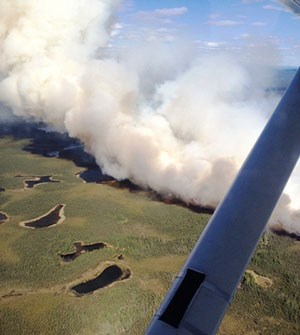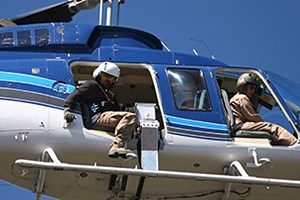

Alaska Department of Natural Resources
Fire management in our national parks combines fire science and ecology, operations, and prescribed fire to maintain fire in the natural ecosystems while adequately considering impacts upon visitors and nearby communities, as well plant and animal habitat. Fire managers follow a plan that specifies the response to fire to be taken in an area - from monitoring and restoration of fire in the ecosystem to full suppression of fires, using a range of management tools, including aviation.
Aircraft Use Increases Firefighter and Public Safety
Wildfires, prescribed fire, hazard fuel reduction, and fire effects monitoring help restore natural processes to ecosystems. Helicopter use allows for timely delivery of personnel to backcountry fires that in some cases would exceed a two-day hike. Protection of human life is the first priority on incidents. Balancing priorities between protecting communities and infrastructure, other property and improvements, and natural and cultural resources is based on the values to be protected, human health and safety, and the costs of protection.
Helicopters and Airplanes Play an Important Role in Managing Wildland Fires
Aircraft are used for a wide variety of missions, including as an “aerial platform” from which managers have an “eye in the sky” view to coordinate ground and aerial assets. Aircraft are also used to deliver firefighters from the air.
Aircraft are used for operational and logistical support during wildland fires. Helicopters, single engine airtankers (SEATs), and large air tankers are used to drop water and fire retardant to slow the spread of the fire.
Logistically, helicopters are most often used to support wildland fires by delivering supplies, equipment, water, and food to personnel on the fireline, but fixed-wing aircraft are used to transport fire personnel over longer distances.

NPS Photo
Prescribed Fire Reduces Wildland Fire Risks and Improves Park Ecosystems
Prescribed fires are conducted to reduce hazardous fuel loads near developed areas, manage landscapes, restore natural habitat, and for research purposes. Aircraft are often used in the same manner for prescribed fires as they are for wildfires. Managers use aircraft to get a bird’s-eye view of areas to be burned before, during, and after a prescribed fire is conducted. In addition, prescribed fires are often ignited aerially with a helitorch or PSD machine (plastic sphere dispenser).
Last updated: July 19, 2016
